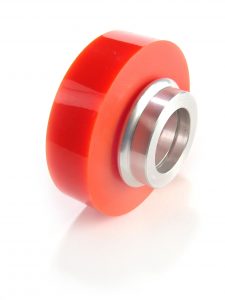Case Study: Dissipating static electricity in urethane rollers and urethane wheels by using an anti-static additive
Dissipating static electricity in urethane rollers and urethane wheels by using an anti-static additive.
Static electricity is an invisible field of protons, neutrons, and electrons found in anything that has potential to move. Each atom has its own properties, and characteristics. One of these properties is called an electrical charge. Protons have what is called a “positive” (+) charge which is the root of static electricity build up in urethane products. Electrons have what is called a “negative” (-) charge. Neutrons have no charge, they are neutral. When an electrical charge such as static electricity builds up it can have a violent discharge when the protons find the easiest path to the earth’s surface called ground.

Rolling friction will cause an imbalance of neutrons if the electrical charge can not get to ground. Urethane by its self is non-conductive and does not dissipate any electrical charge and without the correct formula a dangerous amount of electricity may build up on isolated parts and has also caused problems for industries such as paper factories processing paper with urethane rollers for high-tech equipment. If the urethane were to be produced without an anti-static additive the positively charged wheel and surplus of electrons from processing the paper would cause each surface to stick together once contact was made from the paper to the wheel because of the rule that opposites attract. A perfect example of this is when you rub a balloon against your clothes and it sticks to the wall afterward. A higher charge of static electricity will be heard when the static electricity discharges to ground.

Recently, Plan Tech performed a case study on urethane robot wheels that were non-conductive and building a static charge in the isolated robot. With our team of engineers, we knew from what once saved the paper industry from adding additional grounding wires and warning signs not to touch processing wheels would solve the robot issue as well. Being able to tailor our urethane material allows us to achieve superior results vs similar materials.
Incorporating anti-static additives will offset the number of protons and bring any static build up to the outside of the urethane wheels allowing the protons to neutralize without the violent spark. Being able to dissipate static electricity is critical in many applications where the finished project will be isolated. Anti-Static Additives are low cost with great results at small amounts. Incorporating this additive will keep all the urethane physical properties while creating a much safer environment. The anti-static additive will be mixed completely thru the urethane material and will bring the protons to the outside of the urethane rollers where they can leak into the ground or processing part potentially saving countless hours downtime. Anti-Static urethanes are available in any color or hardness with prototypes available for testing.

